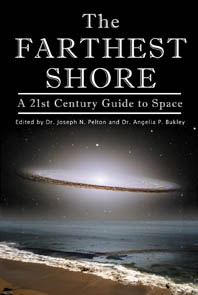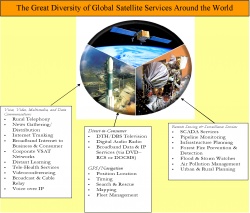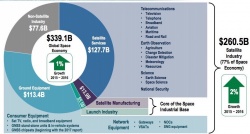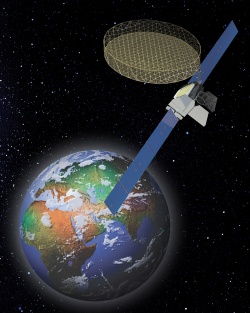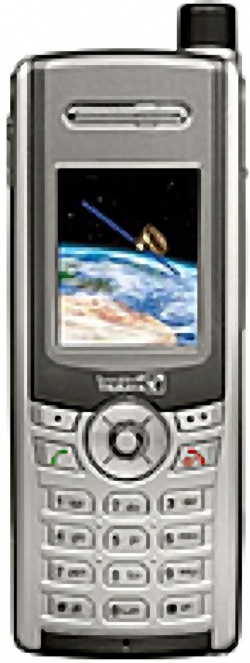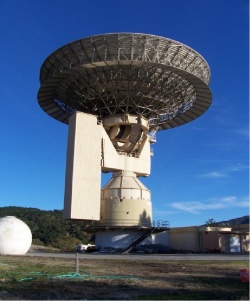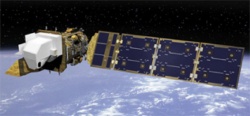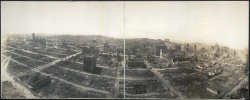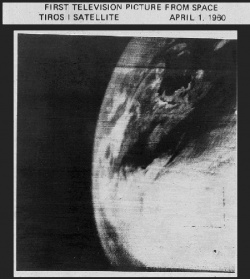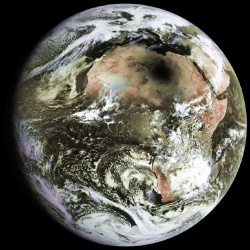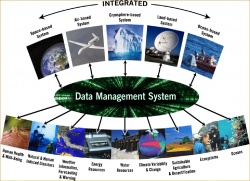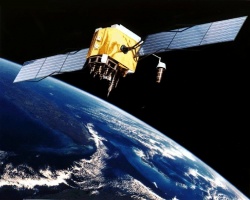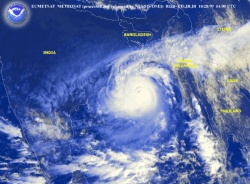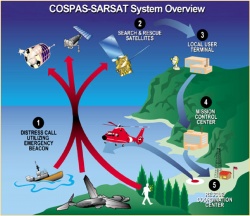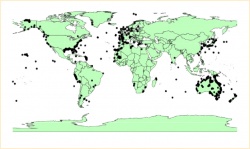The Farthest Shore – Chapter Six Satellites Serving Humankind
From The Space Library
Chapter Six Satellites Serving Humankind
Scott Madry and Joseph Pelton
(With important comments and review by Michel Bosquet, Takashi Iida and Siamak Khorram)
“Thanks to a few tons of electronic gear 20,000 miles above the equator, ours will be the last century of the savage, and for all mankind, the Stone Age will be over.” — Arthur C. Clarke, Father of Satellite Communications
6.1 How Our Orbiting Satellites Serve Us
For over a half-century now various “flying smart machines”, namely satellites, have been able to access space to serve humankind. There are nearly 1500 satellites circling the Earth each day in a variety of different orbits. The majority of these are what might be called “working satellites”. These practical satellites — as opposed to scientific satellites — are providing vital services in a surprisingly large and growing number of applications. Based on the Satellite Industry Association Report prepared by the Tauri Group as of the year end 2015 there were 41 meteorological satellites, 115 surveillance satellites, 97 navigational satellites, 194 Earth observation/remote sensing satellites, 195 civilian governmental and military communications satellites and 511 commercial communications satellites in operation at that time. Although communications satellites predominate in number and commercial revenues the various types of satellites serving the global economy today are vital and important to virtually all nations of the world. All play key roles. The number of these applications satellites continues to grow at about three percent a year but with the growth of new low earth constellations populated by small satellites the numbers and rate of growth will grow at a faster rate. The annual Satellite Industry Association report as carried on their web site is a useful way to obtain the current number of application satellites in orbit.[1]
The word satellite has an interesting origin. It was Galileo who first used the ancient Latin word satelles to describe the moons of Jupiter. This Latin word meant a servant, guard, or attendant of a powerful master or lord in ancient Rome. Thus a satelles scurried around the city to do his master’s bidding and to provide protection to the household he served. The plural satellites meant a retinue of attendants and guards. This seemed an appropriate name for these flying objects, racing around the mighty planets. It is also a most fortunate and accurate term for our ‘artificial satellites’, as they were originally called in the early days after Sputnik was first launched on October 4, 1957.[2] Space satellites truly are the servants of humanity, providing communications, broadcasting, weather data, navigation, timing, mapping, search and rescue, and a variety of other services to humanity.
Today the practical applications of Earth orbiting satellites are almost endless. Satellite applications are a vital aspect of our use of space. Some satellites provide vital governmental services like weather monitoring and prediction, or search and rescue. Altogether the global applications satellite industry- including growth and space systems, as of the end of 2015, was estimated to produce a total of nearly $210 billion (U.S.) in revenues. Over the last decade these revenues have grown at about 3% per year.[3] Figure 6.1 [4] documents the huge variety of space applications today.
The satellite industry involves not only the satellites but also the launchers that put them into orbit, the ground tracking antennas, telemetry and control systems that keep the satellites operating, and the insurance companies that protect against losses and liability claims, etc. These various parts of the industry must all work together for successful satellite services to thrive and grow.
Launch services exist primarily to support the satellite applications markets or the launch of defense-related communications and surveillance systems. Satellite launches for scientific missions and space exploration are actually fewer in number. Launches with humans aboard, although they receive lots of coverage in the press, are only a small percentage of the total number of missions into space. The total commercial market for Earth-orbiting applications satellites, including satellites services, launch services, command and control, is currently well over US$210 billion.[5](It has been estimated that the commercial and governmental combined space markets and related applications and services will grow to a staggering US$2 trillion by 2050.[6])
A breakdown of the global satellite industry on the basis of revenues as of the end of 2016 is provided in Figure 6.2. It is clear from this presentation that revenues from services and especially satellite communications services predominate. Today, however, revenues and especially satellite communications services predominate. Today, however, revenues and applications related to Earth observation and navigation satellites are growing rapidly.
Application satellites also served as the original model for international cooperation in space. Indeed the first satellites Sputnik 1 and 2 (launched by the USSR) and Explorer 1 (launched by the US) were placed in orbit in late 1957 and early 1958 respectively as part of the International Geophysical Year. Many space satellite systems such as those deployed on behalf of the World Meteorological Organization (WMO) of the United Nations, (Intelsat, COSPAS-SARSAT (search and rescue systems), and the Argos environmental telemetry system were early examples of the importance of international cooperation in space. These satellites for telecommunications, meteorology, search and rescue provided practical services to all peoples of the Earth, demonstrating that our access to space is relevant and important to all nations and regions of our planet.
Satellite applications, a truly interdisciplinary arena, are often used together on a cooperative basis. All satellite systems share a common physical science and engineering basis; common elements include launch and deployment, power systems, data processing and transmission, use of assigned frequencies, and systems design, plus policy, legal, and commercial issues. All of these elements and areas of expertise are involved in the successful development of application satellites. Some of these satellites are used both for commercial services and for governmental and defense purposes. Such applications are known as “dual use”. Many commercial applications were developed originally for military purposes and then evolved to become commercially viable. In other cases, commercial satellites were adapted to support military communications or other services.
For instance, the GPS (Global Positioning by satellite System) was originally developed for military uses by the U.S. Department of Defense, but it now supports a host of commercial applications. The military are now a small minority of total users. The satellites developed for defense surveillance purposes pioneered technologies that are now used for commercial remote sensing. Although the U.S. led in deploying such systems, a number of other countries, including Russia, Japan, China, India and Europe have such systems as well.
Satellite communications and broadcasting is by far the largest commercial space activity the commercial space arena in terms of revenues but newer applications such as satellite navigation and remote sensing are now expanding with new applications occurring apace—especially for satellite navigation.[7] Sir Arthur Clarke, the famous writer of science fiction and science fact, is most widely known for writing the screenplay for the film 2001: A Space Odyssey and other science fiction classics. But he is also often called the “father of satellite communications”. In 1945, twelve years before the launch of Sputnik, Clarke published an article in Wireless World that outlined how to use the special geosynchronous orbit. This is a unique 24 hours a day orbit† where satellites appear to “hover” in the same location over the equator as the Earth turns on its axis. Clarke explained how three satellites in this orbit could cover the world for global broadcasting and communications.[8] This orbit where most communications satellites have been deployed over 40 years is sometimes called the Clarke orbit.
† The orbital period is actually 23 hrs and 56 minutes in duration because the Earth is moving around the Sun. There are two terms that are often used almost interchangeably to describe the “Geo”, or Clarke, orbit - geosynchronous and geostationary. The geosynchronous orbit, where the satellite moves in synchronism with the Earth’s rotation in the East-West direction, is relatively easy to maintain. Excursions off the equatorial plane in the North-South direction (i.e. “inclined orbit”) occur on a daily basis so that the satellite moves in an “S-shaped” curve above and below the equatorial plane. Because this is difficult to control, the “geostationary” orbit (E-W and N-S) is hard to maintain.
Arthur C. Clarke’s original vision of the geostationary orbit has made space, especially the comparatively easy-to-achieve geosynchronous orbit, very profitable “real estate”. The space industry employs many tens of thousands of people around the world, and provides routine communications and broadcasting services around the planet. The vision of Arthur C. Clarke has played a tremendous role in creating the global village we live in today.
6.2 Views From Above - The Synoptic Overview
Satellites give us with the best means of viewing, monitoring, and understanding our spaceship Earth. Remote sensing satellites, which provide us with constant weather, climate, planning, and military reconnaissance data all around the globe, have an interesting history, intertwined with dual use military systems. Today, weather satellites constantly monitor the Earth, providing real-time information that we rely upon for trade, commerce, disaster warning and daily life.
Remote sensing satellites of various types image our planet in a variety of portions of the electromagnetic spectrum and at various resolutions (i.e. degree of precision, or clarity) on a constant basis.
It was Plato (ca 450 B.C.) who quoted Socrates as saying “… we are unable to attain to the upper surface of the air; for if anyone should come to the top of the air or should get wings and fly up, …he would see things in that upper world; and, if his nature were strong enough to bear the sight, he would recognize that is the real heaven”.[9]
Space remote sensing has changed the way we think about our planet home. It has also provided a stabilizing influence in geopolitics through the use of “national technical means”, or spy satellites. Satellites supply a daily service, with applications as diverse as cartography, fire monitoring, ocean current mapping, iceberg tracking, urban planning, renewable and nonrenewable natural resources, archaeology, ecology, urban planning, and agricultural crop management.
Precise navigation and timing systems, such as the U.S. Global Positioning System (GPS), the Russian Glonass system, the Chinese Beidou, the Japanese Quasi-Zenith, the Indian Regional Navigational Satellite (IRNS) System and the future European Galileo system, represent another major category of satellite applications that has quickly become part of our modern lives. The ability to determine, accurately and routinely, our position and time using a small receiver has revolutionized our ability to navigate on land, sea, air and in space. Satellite navigation and timing services are used routinely for car and truck navigation, for the tracking of wildlife or hazardous materials, for regulatory enforcement, and to time-stamp every “packet” which crosses the internet. They are even used on Hollywood film cameras for ease of editing. The current satellite navigation market exceeds US$25 billion per year market, with 20% growth per year and an incredible number of GPS receivers sold per month since they are now embedded in all smart phones on a chip.[10]
Space telemetry systems, such as the ARGOS environmental positioning and telemetry system, transmit routine environmental data from marine buoys around the world’s oceans, provide remote environmental monitoring, and track endangered species and hazardous materials. Satellite search and rescue systems like the international COSPAS-SARSAT system have saved thousands of lives each year, and have made the worldwide search and rescue process both more efficient and safer.
Each of these capabilities on its own provides practical benefits and important commercial markets, but it is the functional integration of these tools that is creating many of the new applications and emerging commercial markets. Geomatics, or Geoinformatics, are terms used to describe the integration of these related but previously separate capabilities. Integrated mobile communications, positioning, data, and imaging are having a major impact on human societies around the world. Consider the integrated use of space-related tools in Google Earth, now accessed by many hundreds of million people around the world.[11]
For precision agriculture, weather satellite data are combined with GIS information of natural resources and agricultural productivity, GPS-controlled irrigation and fertilizer application, and crop monitoring from satellites into an integrated information system. The synergy provided far exceeds the benefit of each individual component. However, there are very important legal, policy, economic, dual use, and social implications in the continuing development of these tools.
6.3 Critical Services from Today’s Communications Satellite
Satellite communications is actually a broad term that covers a wide variety of markets and technologies. Broadcast television and entertainment, broadband Internet services, mobile service to airplanes, ships and hand-held and portable units, are just some of the services. Figure 6.1 notes the true diversity of satellite services now available.
Thus the field of satellite communications is actually divided into a number of different categories of service that operate at different radio frequencies and use different types of antennas on the Earth or the oceans. These services are defined by the United Nations agency known as the International Telecommunication Union that is responsible for assigning bands of radio frequencies for the various applications. The three most important communications satellite services are: (i) fixed satellite services (FSS) where user antennas are at fixed locations and support all types of telecommunications services; (ii) broadcast satellite services (BSS) where entertainment and news services are broadcast to end users (typically to very small and low cost terminals) in their own homes and offices; and (iii) Mobile Satellite Services (MSS) where satellite services are provided to end users with mobile transceivers (like specially equipped cell phones with antennas large enough relay messages to and from orbiting satellites.
6.3.1 Broadcast Satellite Services—News and Entertainment to and for Everyone
The largest single sector in the entire satellite applications industry, in terms of revenues, is that known as broadcast satellite services (BSS) or, as it is sometimes called, the Direct Broadcast Satellite (DBS) Service. These broadcast satellite systems, with estimated total revenues well over US$100 billion a year provide news and entertainment and even health and educational information to a growing percentage of the world’s population. They provide video (television) services to every continent on Earth - even Antarctica. There are, however, also direct broadcast systems for audio (radio) services.[12]
Some of these direct broadcast systems such as Worldspace and XM/ Sirius are designed to provide radio broadcasts (even though they can deliver some compressed video if broadcast at low rates and stored on a computer). Also the BSS/DBS satellites can deliver high definition television, conventional television in a digital or analog format and/or audio and radio programming. There are hundreds of millions of subscribers for direct broadcast services around the world. Europe, with over 100 million subscribers, is where this type of satellite service is most concentrated, but it continues to grow on all continents. Typical terminals (“dishes”) to receive satellite television broadcasts are in the range of 35 cm to 1 meter. Radio broadcasting systems require units that are only ~10 cm in size; they are now being built into new cars in the US.[13]
6.3.2 Mobile Satellite Services (MSS)
The fact that people can now buy a hand-held “satellite transceiver” that can communicate to and from a satellite, and which is very much like an extension of cell phone service, is truly remarkable. Mobile satellite services first started with communications to ships at sea via the so-called Inmarsat (once the International Mobile Satellite Organization system and now Inmarsat Ltd.) some three decades ago. Then this service extended to commercial airliners and defense-related aircraft. Beginning in the 1980s was a land-based mobile satellite service. To close the link between the satellite and very small user terminals, significant power is needed. Some of the first of these systems, like Iridium and Globalstar, operate in low Earth orbit constellations (with a combined network of some 50 to 70 satellites orbiting the Earth). Other satellite systems have deployed very large antennas in space from the Geo orbit. Figure 6.3 [14] shows the Thuraya satellite, built by the Boeing Corporation, that beams sufficient power to close the link to the very small transceivers on the ground.
The powerful beams from the Thuraya satellite allow communications to the small hand-held transceiver shown in Figure 6.4 [15]. Its small antenna can communicate to the satellite, and is extremely small compared with the first giant antennas used at the start of the satellite age in the 1960s. The first satellite “Earth stations” that communicated with the first, very small satellites weighed hundreds of tons and required large round-the-clock staffs to maintain them.
This transformation is thus even more dramatic in scope and scale than the computer revolution characterized by “Moore’s Law” (named after the co-founder of the Intel Corporation). This law states that the performance of computer chips doubles every 18 months. This amazing standard of exponential improvement has been achieved in the computer industry over the last two decades. But satellite Earth terminals have achieved improvements in performance equivalent to a doubling of overall performance every year. The contrast between the hand-held satellite phone in Figure 6.3 and the 30-meter diameter and multi-ton Standard A Earth stations that were used by the earliest Intelsat satellites in the 1960s is indeed one of the most remarkable technological transformations imaginable. This change, sometimes called “technology inversion”, has seen the satellites grow from small units to very large multi-ton satellites while the antennas on the ground have shrunk by a factor of more than a million times. The size of these initial Earth stations is shown in Figure 6.5.
6.3.3 Fixed Satellite Services (FSS) and Application
The initial satellite services were in the fixed satellite services (FSS) band. These services started out with trans-Atlantic telephone services and simple black and white television relays, but today these services, in the age of the Internet and advanced IT, are much wider. Broadband satellite services today have exploded into a wide range of activities. The following are a few examples of the vital services that satellites now provide across the world.
(Graphic courtesy of www.iots.com/comsatlegacyproject).
6.3.3.1 Electronic Funds Transfer (EFT) and Business Services
The speed and volume of electronic funds transfer today is tremendous; the World Bank reports that transfers on the order of US$200 trillion took place in 2007. This is about 2.5 times the entire collective Gross National Product (GNP) of all the countries in the world.[16] Global and national commerce depends on rapid and secure electronic transfers taking place, and rapid authentication of credit card purchases at service stations, grocery and drug stores and shops. Fiber and satellite networks all over the world make this possible. It is not widely known that satellites are used routinely to verify credit cards and support Very Small Aperture Terminal (VSAT) networks among automobile dealerships, retailers, banks, and distributed businesses everywhere. Satellites connect Wi-Fi/Wi-Max hotspots, and support corporate training networks, decentralized corporate enterprise networks, teleworking virtual private networks (VPNs) and more. Countries without extensive fiber networks are particularly dependent on satellites for such business services, but such satellite networks are found all over the world.
6.3.3.2 Cable Television
One of the surprising facts about FSS networks is that cable television systems would not exist without satellite distribution to provide the programming at the “head end” for cable television networks. Premium movie channels like HBO, Showtime, Starz, news channels like Viznews, Reuters, CNN and specialized channels on cooking, travel, animal life are all distributed to local cable television channels via satellite. So called Earth station “antenna farms” that receive national and international television programming can be found at the head end of cable television stations. Large cable television companies, known as multi-service operators, are closely tied to the satellite industry to bring them their 24-hour a day program from around the world. Large television networks are equally dependent on satellites to bring them news and sports from all over the world. The coverage of the Olympic games, with up to two billion viewers, is dependent on hundreds of on-site satellite uplinks to provide the programming in local languages to over 100 countries around the world. Communications satellites are at their best when they are used to broadcast over large areas, or connect a very large network, or provide a link to a remote or unexpected new location. Satellites represent the flexible technology needed to perform these types of tasks. Much is written about the competition between satellites and fiber technology, but in many cases it is a hybrid network that combines satellites and fiber to create the optimum solution. Satellites have remarkable capabilities, whether they are beaming the Olympics to the world, providing tele-education or tele-health to a remote village, or supporting telework for a multi-national corporation linking together tens of thousands of employees.
6.3.3.3 International Development
Increasingly it is fiber networks that carry the heaviest traffic across the Atlantic or Pacific or provide the critical telecommunications networks in large cities. Clearly optical links provide the highest capacity and most cost-effective pipes connecting large cities. Yet, for many locations where there is limited development or steep mountain ranges, or tropic jungles, or deserts, or many islands to interconnect, satellite networks rise to the forefront. Satellites, in short, represent the key technology that transcends barriers and allows flexible and instantaneous interconnection. Island countries in the Pacific have achieved surges of economic progress by being able to use satellite connections to negotiate better prices for their imports and to sell their exports at international market rates rather than accepting the price offered by local steamer companies. Communications to and from over half of the world’s 200 countries and territories today depend heavily on satellite communications. This is true not only for international connections, but for communications to rural and remote parts of their own lands.
Algeria established a domestic satellite network by leasing capacity from the Intelsat international satellite network in the early 1970s.Thus Algeria became the first of the developing countries to find a cost-effective way to establish a national television and telephone network across the Sahara Desert. Today scores of countries in Africa, South America, Asia, Oceania and the Middle East have leased capacity from international satellite networks to create local networks for television, radio and telecommunications. Other larger, developing and industrializing countries, such as Argentina, Brazil, China, India, Indonesia, Malaysia, Mexico, Nigeria, the Philippines, Taiwan, Thailand, and Turkey have launched their own domestic satellite systems.
6.3.3.4 Tele-Education and Tele-Health Service
Most people think of communications satellites as promoting broadcast entertainment, news, sports, business services, and government and defense-related services, but satellites have proved to be a powerful tool to promote and deliver education and health care services. At first these satellite systems were developed in the 1970s and 1980s to provide services in the remote parts of Canada, of the USA (Alaska and Appalachia), and the USSR. As international satellite systems and domestic satellite systems spread around the world, the use of satellites to deliver education and health care has spread widely. There are satellite networks that are critical infrastructure for the University of the West Indies, the University of the South Pacific and other regional groupings. The Chinese National TV University that started in the mid 1980s as part of the Intelsat Project Share (Satellites for Health and Rural Education) is now the largest of such tele-education networks in the world, with over 10 million students and over 90,000 terminals all over rural China.[17] Indonesia’s domestic satellite system known as Palapa supported business and telecommunications, but it also continues to support a national satellite-based educational program. The Republic of South Africa has a major distance learning program via satellite called Mindset. Mexico’s government has now deployed one of the most modern and extensive satellite education programs in partnership with the Via Sat Corporation. Argentina, Brazil, Colombia, Ecuador, and Venezuela also have satellite education programs, using either dedicated national satellite systems or leased satellite capacity. Brazil’s program for the Amazon covers the vast rainforests to provide educational services.
India has launched its own satellite dedicated to health and education. This program known as Edusat serves millions of students and thousands of villages. Satellites are used in developed countries for education and training, with most of the countries of the Organization for Economic Cooperation and Development (OECD) having a variety of programs. Overall, many tens of millions of students receive important educational programs via satellite or a combination of satellites and Internet connections.
The delivery of health care via satellite is much more difficult and demanding that tele-education. The technical requirements for health care services via satellite, in terms of interactive communications and the resolution of video images, are severe. Also questions of liability and misdiagnosis may arise. The use of satellites to distribute health care information, to provide basic information on nutrition, treatment for diarrhea, prevention of AIDS and sexually transmitted diseases (STDs) have already helped save thousands of lives.[18]
6.4 Eyes in the Sky—Remote Sensing
Remote sensing is the art, science, and technology of obtaining reliable information about an object, a feature, or other phenomenon by recording, measuring and interpreting data from a distance, all without being in physical contact with what is being analyzed. For instance, our eyes and ears are remote sensing devices, while our senses of touch and taste are not. The data used in remote sensing can be visible light that falls on the human eye or a photographic film that is developed and interpreted by the brain, or by advanced electronic sensors. Space remote sensing systems have been developed that use sophisticated devices to measure electromagnetic radiation outside the normal visual range, in the shortwave, thermal infrared, RADAR (Radio Detection and Ranging), microwave, LIDAR (Light Detection and Ranging), and ultraviolet, as well as multi-spectral sensors that record data from a wide range of the electromagnetic spectrum at once. Systems can be of various different designs. Active sys-tems like RADAR and LiDAR send their own burst of energy out to be recorded when received at a sensor, whereas passive systems simply record the energy at a sensor that comes from the Sun or that is emitted from the Earth. The Landsat remote sensing satellites (see Figure 6.6 [19]) were among the first of these Earth observation satellites, first launched in 1973, and with much improved systems, remain the longest-running civilian remote sensing program.
The data that are acquired in space must be stored, transmitted to Earth, and then processed into useful information using a variety of digital image processing techniques. The resulting information is then used for a wide variety of scientific, engineering, commercial, national security or military tasks. There are hundreds of applications, including:
- Military reconnaissance and intelligence gathering, target recognition, target tracking
- Earth resources, including agriculture, forestry, geology, oil and minerals prospecting,
- Environmental monitoring and Earth Systems Science, including ecology, global studies, ecosystems analysis and disaster studies
- Cultural, urban and demographic studies, including urban growth and planning, human dimensions of environmental change and archaeology; for instance, the McDonald’s Corporation is one of the biggest users of remote sensing data, not so much to monitor potato crops as to decide where to locate future franchise restaurants
- Ocean and marine studies, including water quality, fishing, pollution monitoring and oceanographic science
- Atmospheric studies, including weather and meteorological analysis, weather forecasting, severe storm tracking, pollution monitoring, hazards such as volcanic eruptions, and upper atmospheric science, and
- Geodesy, geodetics, surveying and mapping the Earth.
There are many more. The same technologies are used in planetary remote sensing and for astronomical studies, and there are many commonalities with these systems that image other worlds.
6.4.1 History and Development
The very first humans engaged in remote sensing when they surveyed their environment from a hilltop to locate food, threats, or to gather resources. The first aerial remote sensing was accomplished from balloons in the late 1700’s.[20]
The first aerial photograph was taken by ‘Nadar’ of Paris in 1858 from a height of 80 meters. Balloons, kites, and even pigeons were used to carry early film cameras aloft to obtain the first aerial views of our world. Alfred Nobel designed a photo rocket in 1897 that took aerial pictures in Sweden, and Dr. Julius Neubronner of Germany patented a miniature pigeon camera in 1903. The aftermath of the April 16, 1906 earthquake and fire in San Francisco was photographed from a large kite, with pictures such as Figure 6.7 [21] being published in newspapers around the country.
The oldest surviving aerial photographs are of Boston, Massachusetts, taken by S. A. King and J. W. Black in 1860. The first aerial photographs were taken from an airplane by the Wright Brothers, and World War 1 provided a major impetus in the development of both military and civil remote sensing, with the development of practical aerial photography, aerial cameras, new films, and the techniques to interpret these photos and produce accurate maps. The first “black and white” infrared film was produced in the 1930s. The Eastman Kodak Company developed the first commercial infrared film in 1938, which expanded our ability to see beyond the visible part of the spectrum for the first time.
In the Second World War new technologies for aerial photography and remote sensing were developed, including color infrared film used to locate camouflage. As well as the many military reconnaissance photographs taken and maps made, thousands of pilots and photo interpreters were trained; surplus airfields, aircraft and cameras led to the rapid development of aerial photographic remote sensing as the primary means of mapping and interpreting our world. The cold war and the dawn of the space age provided the impetus for the development of remote sensing from space.
6.4.2 Eyes from Space, Remote Sensing in the Space Age
Space is the high frontier from which to conduct global meteorological, military, and environmental analysis. In the 1950s both the Soviet Union and the United States developed space photographic systems for military reconnaissance and national security purposes, and all modern space remote sensing systems are the direct descendants of these. The Soviet Zenit spy system, using the same Vostok capsule design as launched Yuri Gagarin, was approved in November 1958, and was first launched in December 1961. Ten of the first twenty Cosmos launches were secret photoreconnaissance satellites. The now declassified CORONA system of the USA, also approved in 1958, first recovered film in August 1960 after thirteen failures in a row. Over the life of the program, which ended in May 1972, CORONA had over 100 successful missions and photographed over 14.2 million square km of the Earth. These data are now available on the internet for research. Later, the US Skylab and Soviet Salyut, Almaz, and Mir orbiting labs carried extensive remote sensing systems having diverse objectives. The great majority of all remote sensing satellites ever launched have been military reconnaissance systems, and modern national security imaging systems are currently operated by many nations.
The potential civil benefits were also evident. President Eisenhower’s Science Advisory Committee reported in 1958 that satellites will, in time, turn their attention downward. The Committee thus projected that satellites held promise for meteorology and the eventual improvement of weather forecasting. In fact, the most beneficial aspect of space remote sensing is probably the development of weather “eyes in the skies” to warn us of dangerous weather conditions and to use new observations to improve weather forecasting. TIROS (Television and Infra-Red Observation Satellite), the first dedicated weather satellite, was launched in 1960. This began as a Defense department program but was transferred to the new civilian NASA agency in April 1959. TIROS acquired its first image on April 1, 1960; this is shown in Figure 6.8 [22].
The first dedicated civil Earth remote sensing satellite was the NASA Earth Resources Technology Satellite (ERTS-1), launched on July 23, 1973. The system was later named Landsat, and the Landsat program continues with Landsat 7, which is now in operation, although in a degraded state The French entered the civil remote sensing market in 1986 with SPOT 1 (Satellite Pour l’Observation de la Terre) launched on February 22, 1986. Since the advent of the SPOT civil and commercially based system, many other civil remote sensing systems have been launched by a number of countries, plus several private companies around the world. Many countries have mid-to-high spatial resolution remote sensing satellites in orbit today, and more are planned. There are also many new active radar systems in orbit, with Canadian, JAXA, and ESA programs being quite prominent. There are many more commercial satellites today, as well as military systems.[23]
The optical systems can be divided into 2 high and 3 medium spatial resolution groups:
- very high spatial resolution (0.41 to 1m) and high (1.8 to 2.5m)
- high-medium (4 to 8m), medium (10 to 20m) and low-medium (30 to 56 m) spatial resolution.
This combination of systems gives a wide range of potential applications. A Forecast International study in 2006 projected the delivery of 139 imaging satellites worth US$16.3 billion over the next ten years.[24] A major question that may arise from these projections is: why so many similar satellites are being developed and launched? What is driving this? Major drivers include national pride, military dual use, and high technology, economic development and economic competitiveness. There are no internationally operated, shared remote sensing systems, although this would make sense.
6.4.3 Orbits of Remote Sensing Satellite
There are two basic orbits that are used by Earth remote sensing satellites - geosynchronous and Sun-synchronous polar orbits. As noted earlier, the geosynchronous (GEO, or Clarke) orbit provides a satellite whose position is fixed in relation to the Earth’s surface with respect to the equatorial plane. Although the geosynchronous orbit is primarily the domain of tele-communications satellites, meteorological satellites also use this orbit. This is a splendid orbit from which to look down on the Earth to have a constant and synoptic “weather watch” of over a third of the world’s surface. Geosynchronous weather satellites are currently operated by the USA, Europe, India, China, Japan and Russia. These satellites ring the Earth and provide weather information at all longitudes on a constant “24/7” basis. Global weather patterns, severe storms, and cyclones are routinely monitored using these.
The Sun-synchronous polar orbit is a much lower orbit, usually from about 400 to 800 km altitude. In this Low Earth Orbit (LEO), the satellite passes over the Earth’s surface from pole to pole on a repeating basis, as the Earth rotates under the satellite’s polar orbit; one orbit of the satellite takes around 90 minutes. Satellites in polar orbit give a more detailed view of the Earth and its atmosphere, so this is the domain of most remote sensing satellites.
6.4.4 Weather Satellite
TIROS III made the first observations of a hurricane from space in July 1961; the global hurricane watch program that continues in operation today was started using TIROS IV in September 1962. Daily global weather coverage started with TIROS IX in January 1965, and continues today. (See Figure 6.9)[25].
There are currently seven geosynchronous weather satellites: the US GOES East and West over the Eastern Pacific and Western Atlantic over the Americas, Meteosat over Africa and Europe, Indian Insat, Chinese Fen Yung, and Russian GOMS over the Indian Ocean, and the Japanese Himawara over the western Pacific. Having weather and environmental data over the entire Earth for 24 hours a day is vital for forecasting severe weather events, as well as for gathering data showing changes in local and global environmental patterns. The individual observing instruments differ in design, but generally record and transmit data in the visible, thermal and water vapor parts of the spectrum; they observe cloud top temperatures, sea surface temperature, and winds. The coverage can be global or the instruments can zoom in to view smaller areas of special interest.
The satellites and their data are only one part of a complex system to study the Earth’s weather on an operational basis that includes ground receiving and processing stations, as well as facilities to analyze and distribute the data. Weather Fax (WEFAX) is a direct communications transponder service provided through the satellites. It involves the retransmission of low-resolution imagery and other weather data from the satellites to relatively low cost receiving units located on ships at sea or on land in remote locations. WEFAX enables the greatest possible number of individual users to have access to weather imagery and related data around the world. More detailed data are also sent to ground receiving stations, e.g., for use by weather forecasters, with the data being distributed by television, radio, and other news media.
6.4.5 Polar Orbiting Systems (POS)
The polar orbiting satellite systems have much higher spatial resolution than is possible from GEO, and so giving more detail; the spatial resolution of one “pixel” (picture element), or area on the ground sensed at a time, ranges from 1 km down to 1 m or even less. Low resolution POS satellites view the same part of the Earth once or twice a day from their low polar orbits, while high resolution systems can take several weeks to revisit your town. There are many national, military, and commercial systems that are used for a wide variety of applications, some general and others with specific purposes. There has been an explosion in the number and types of remote sensing satellites, including small satellites, with many from developing nations such as Nigeria, South Africa, and South Korea - remote sensing is no longer the domain of the super powers. Recent developments in technology have enabled these systems to have a much broader community of users; this trend will continue. The website associated with this book gives a detailed list of current and planned future space remote sensing systems.
A recent and very exciting development is the new generation of very small size constellations of remote sensing systems such as those operated by Planet. These are 3-U cubesats, with a spatial resolution of a few meters, that are being launched by the hundreds, offering daily imaging of our world. There are several other new entrants to this new approach to civil remote sensing, and the cube sat revolution is radically changing the remote sensing landscape.
6.4.6 Remote Sensing Application
According to a recent survey, 41% of remote sensing data are used for national security and defense, 17% for mapping and cartography, 15% for civil governmental use, 5% for transportation, and 4% for environmental analysis. Agriculture, wildlife, resource exploration, forestry and all other uses are only 1-2% each.[26] There are very many interesting applications; the integration of satellite imagery with GPS, GIS, in situ data, and other sources greatly increases the utility of the remote sensing data. Some of the primary remote sensing applications are discussed in the next section.
6.5 Global Issue
Our world faces a wide variety of global issues today. Satellite data are, in many cases, the best means to study and monitor the health of “spaceship Earth” in an integrated and comprehensive manner. Satellite data are currently acquiring daily and global information on a wide range of atmospheric, land, water, and ice phenomena. These include information on global vegetation cover, ocean productivity, global biosphere change, ocean temperature, ocean wave height and direction, ozone levels, atmospheric pollutants, snow and ice extent. Major global issues, e.g., stratospheric ozone depletion, sea level rise, ocean pollution, deforestation and the human dimensions of climate change can be studied using a combina-tion of satellite data, in situ data, and GIS information.
There are many national and international issues relating to the acquisition, storage, and use of remote sensing data. Private companies operating remote sensing satellites maintain copyright on the data; there are a variety of legal and policy issues relating to these data and their applications discussed in chapter 9 of the book. There are also complex issues relating to data structures, data standards, metadata (descriptive information about the data), and descriptions of data processing that are all part of the remote sensing data analysis process. Who gets to use these data, who can afford them, and how data can be shared and processed are all important aspects of remote sensing.
6.5.1 Resource Exploration
Remote sensing data are used for a wide range of geological, minerals, energy and mining applications. Surface features can provide important clues to subsurface deposits of gas, oil, minerals and water. Geological analysis and prospecting has been done using aerial photography for many years, but space imagery provides important advantages including much more synoptic coverage, a wider range of spectral bands, and the integration of multiple data sources in the GIS environment. Bare rock and soil can be distinguished in the Near-Infrared (NIR band) at wavelengths of 2.0 to 2.4 µm. Individual minerals can be identified using digital image analysis. Extremely large areas can be surveyed and analyzed using these techniques, but ground verification is always required.
6.5.2 Anthropological Research
One of the more interesting applications of space technology is the study of human origins - anthropology and archaeology. Satellite images provide anthropologists and archaeologists with a powerful tool to map changing settlement patterns, modern vegetation and infrastructure in remote areas. Whilst archaeologists have used aerial photographs to locate archaeological sites since the 1920s and Charles Lindbergh did aerial prospecting for sites in the southwestern US and Central America in the 1930’s, modern, ultra high-resolution satellite images empower archaeologists to search for buried structures, old roadways and field boundaries from their offices. Remote sourcing tools have been used to locate a wide variety of archaeological features using Google Earth.[27] These satellite-detected sites were later verified, by making “ground truth” visits, as valid archaeological locales.
Another interesting example is the research done in Africa on mountain gorillas. Radar-based remote sensing from space provided vital base mapping of the Virunga mountain gorilla reserve in Rwanda, Uganda, and the Democratic Republic of Congo. These locations are often shrouded in clouds and mist, which radars aboard satellites can penetrate. Vegetation maps were created, and GPS units were used to track gorilla movements as well as evidence of illegal poachers. These data were entered into a Geographic Information System (GIS), which is used to protect the gorillas, track poachers, manage the park and support scientific analysis of the gorilla population.[28]
6.5.3 Flora and Fauna Monitoring
Vegetation monitoring is one of the oldest types of remote sensing data analysis. Remote sensing data are analyzed using digital image processing techniques to determine land use and land cover classifications accurately. Their uses include forest management, where timber resources can be monitored for disease and health. Agricultural areas can be routinely inspected from space to determine the health of crops, disease or pest infestations, when crops are ready for harvest, and even to forecast overall crop productivity. Several international organizations, national governments and private corporations use space-based remote sensing, combined with GIS, to monitor global commodity crops such as wheat, oil seeds, cocoa, and rice. They produce monthly crop forecasts for global commodity markets, companies and individual countries.
6.5.4 Precision Agriculture
Remote sensing, GIS, and GPS data can be combined into an integrated system to provide significant benefits to agricultural production at a local scale. Precision agriculture is a new technique where farmers integrate their equipment with precise GPS receivers and detailed GIS information about the soils and fields to improve the management of land and to obtain a more efficient use of machinery, personnel, water and pesticides. The status of crops monitored over the growing season is combined with detailed soil information and previous yield data to indicate specific actions for the farmer. Tractors carrying computers and GPS equipment then apply seeds, fertilizer, pesticides and water for each specific square meter of the ground, rather than simply applying large amounts over entire fields, to achieve greater yields at lower cost. Reduced pesticide and fertilizer use provides net economic benefits ranging from US$5 to US$14 per acre. Precision agriculture significantly lowers the environmental impact of pesticides and fertilizer, and reduces the water required for irrigation, while simultaneously improving the overall yield and reducing both direct costs and the environmental impact.
These are only a few of the many applications of remote sensing data.
Military and defense, urban planning, and forest inventory activities, along with meteorological, oceanographic, and atmospheric studies are amongst a wide variety of commercial and scientific applications conducted around the world on a routine basis. The application can range from mundane (e.g., where to put a new shopping mall) to humanitarian (e.g., aiding disaster relief after the most recent earthquake, tsunami or flood.
6.6 GEO, the Group on Earth Observations
Remote sensing and geomatics are now becoming increasingly international in scope. With so many nations launching remote sensing systems there is a danger of having many expensive and perhaps even redundant capabilities. A fairly recent development has been the establishment of GEO, the Group on Earth Observations. GEO is a partnership of over 70 national governments and over 50 international and regional organizations that was formed in 2002. The goal of GEO is to provide a framework for improved cooperation and coordination of programs and data, and to address nine areas of Earth observation “societal benefits” including disasters, health, energy, climate, water, weather, ecosystems, agriculture and biodiversity. (See Figure 6.10)[29].
GEOSS is the GEO System of Systems, which addresses common user requirements, data, and processing data into useful products from a global and coordinated viewpoint. The GEONETCast system is designed to disseminate space, airborne, and in situ data and products around the world. This will use existing commercial satellite telecommunications capabilities to broadcast Earth observation data around the world to low cost reception stations for a wide variety of users.
6.7 Our Amazing Tools in Space
6.7.1 The Fundamentals of Remote Sensing Data Handling
Space remote sensing data are transmitted via a telemetry system to the ground for analysis and distribution. The general sequence of procedures includes:
- Acquiring the raw data collected by a sensor on the satellite platform
- Storing the data onboard and the sending them to the ground using telemetry
- Preprocessing at the ground facility to remove systematic errors and to prepare the data for analysis
- Entering the data into a computer analysis system
- Georeferencing the data to a given map coordinate system, or projection
- Enhancing and digitally manipulating the data, such as classifying land use or vegetation cover, water temperature, or atmospheric pollution content
- Conducting ground verification field work or other external data analysis
- Exporting the processed data into a Geographic Information System (GIS) for integrated analysis with ancillary data, maps, other imagery or related data, and
- Conducting the analysis or scientific research, presenting and publishing the results, etc.
6.7.2 Sensor
There are many types of remote sensing sensors. Dental X-rays, airport metal detectors, ship and weather radars, cell phone cameras, and police traffic radars are all examples of common remote sensing systems used around the world on a daily basis. For space remote sensing, our sensors have common features to record the electromagnetic waves that have interacted with a target. All types of physical matter, such as vegetation, the bare soil, or the surface of the ocean interact with electromagnetic energy in different ways. They can absorb, reflect, scatter and emit energy at many different wavelengths so that we can detect, identify, classify, and describe the target material without being in direct contact with it.
The total energy received by a remote sensing instrument is recorded in various wavelength bands, which are referred to as spectral bands. Measurements over several bands can be combined to make up a spectral signature, a response pattern unique to each material. The source of the energy that is detected divides remote sensing sensors into two categories: passive and active. Passive sensing works by collecting energy from the Sun or thermal heat from the remote energy source, e.g., the atmosphere. If the satellite illuminates the target using its own source of radiation, such as radar, then the system is termed an “active system”.
In modern electro-optical systems, the sensor produces a signal, an electric current that is related to the number of photons that are striking a photoelectric detector. Albert Einstein was awarded the Nobel Prize in 1921, not for his much greater discovery of relativity, but for his work on the photoelectric effect. Simply stated, this is the emission of electrons from a negatively charged plate of some appropriate light-sensitive material when a beam of photons strikes it. This flow of electrons can be measured as an electrical current. This signal is converted into a digital number, stored onboard and later transmitted to the ground for analysis by a computer and an analyst.
The electromagnetic energy of various wavelengths emitted by the Sun or an active transmitter on a satellite interacts with the atmosphere, land, ocean, or vegetation in different ways. Some energy is reflected back to the satellite, some is scattered, and the target absorbs some. On its way back through the atmosphere part of the energy is absorbed and scattered, but some does get back to the satellite and falls on our detector. The detector acting as a photon counter generates an electrical current that depends upon the amount of energy that reaches it. That is recorded on the satellite and converted into a number that is sent to the ground for analysis.
6.7.2 Resolution
Each type of remote sensing sensor has unique characteristics and is useful for a particular application. There are four types of resolution, which characterize our sensor, and which we now consider.
6.7.2.1 Spatial Resolution
This defines how small an object can be distinguished on the ground, and how large an area is covered in each orbital pass. In digital systems this is defined by the picture element, or pixel size, of the “instantaneous field of view” (IFOV), which is equal to the smallest area on the ground that the detector can pick out. The swath width is the full width of the ground (typically >100 km) observed as the satellite moves along its orbit.
6.7.2.2 Spectral Resolution
This denotes the particular portion of the electromagnetic spectrum that is sampled by the detector. For example, near infrared is very useful for vegetation analysis, while mid-infrared is more useful for geological prospecting. In recent years the introduction of what is called hyperspectral sensing has allowed development of much more precise information and spectral signatures for specific crops, trees, types of soil, and pollutants at a precise location. Instead of providing information over just three to five spectral bands, hyperspectral sensing devices might divide the spectrum into 100 to 300 individual bands. The product of hyperspectral processing is called a hyperspectral cube. Data is thus displayed for the area sensed as square with the spectral data shown behind in the form of a three dimensional cube.
6.7.2.3 Radiometric Resolution
This defines how accurately the digital sensor records the data, usually measured in terms of the number of bits of data. Older sensors were 6 bit, meaning that they could measure the amount of energy falling on the detector in the range from 0-63, or 2 to the 6th power. Later systems were 8 bit (256 categories), and now we have 10 bit sensors with a data range from 0-1023 and even 12 bit data with a range of 65,536 values. More refined measurements allow us to characterize the target more accurately and hence determine the composition of the target better, in the same way that hyperspectral measurements do.
6.7.2.4 Temporal Resolution
This is the time interval -usually some days -between successive observations of the same place on the Earth as the sensor travels on our Sun-synchronous polar orbit; its inverse is the revisit rate for the on-board sensor. The time interval is related to the altitude of the orbit, the swath width on the ground and the latitude (how far North or South) is the region where we require data. By way of contrast, geosynchronous satellites have a temporal resolution of several minutes, as the sensor constantly scans the Earth’s surface. If we are using optical or multi-spectral scanners, rather than radar, and the area we are trying to monitor is covered by clouds, it could be a long time before we can obtain good data, even if the revisit rate is quite high.
6.7.3 Active Remote Sensing System
There are important differences between active and passive sensor systems. Passive systems generally record the number of reflected solar photons falling on a detector in a given time. But what happens at night?
They cannot work. Active systems generate their own scene illumination, by sending a burst of energy that is reflected off the target and recorded by the sensor. These systems, often radar systems operating in the microwave region of the spectrum, at wavelengths between 2 cm and 0.25 m, can operate at any time of the day or night, and can even see through clouds and rain, and penetrate a short distance under water or below the ground. Active systems provide a day/night rain/shine remote sensing capability that is very complementary to passive systems.
Radar systems produce very different information from that deduced from passive systems like Landsat or SPOT. Radar sensing satellites send a burst of coherent energy to the target and measure the time and intensity of the returned energy. The radar systems operate at very high power. For example, the ESA ERS-1 system could only operate the radar for some 8-12 minutes each 90 minute orbit, due to power and data storage limitations. The returned data are very complex, and depend upon the roughness of the surface, its moisture content. They require much processing in a dedicated ground-based processor to create visible images. Synthetic aperture radar uses the motion of the satellite to “synthesize” an antenna that is over a kilometer long, to obtain a good spatial resolution. New high resolution commercial systems are now available that provide spatial resolution of a few meters, and these data can be integrated with high resolution passive data for a more complete view of our world.
LIDAR (LIght Detection And Ranging) is another active system, which transmits pulses of coherent visible light to the target. It uses reflected or scattered coherent light from a laser on the satellite to determine the distance to and from a target, and/or to provide information about the target. While mainly being used in aerial remote sensing at this time, LIDAR has a wide range of applications, including investigating aerosol characteristics or winds in the atmosphere, locating geological faults, mapping historical or archaeological sites, measuring ocean waves, and producing detailed topographic maps. The joint US NASA/French CNES CALIPSO satellite (Cloud-Aerosol Lidar and Infrared Pathfinder Satellite Observation) was launched in 2006, and provides the global observation of clouds and aerosols to understand their role in the Earth’s weather and climate. The Mars Orbiting Laser Altimeter (MOLA) was an instrument on the NASA Mars Global Surveyor that produced detailed elevation maps of Mars.
6.8 Future Trends in Remote Sensing
Environmental analysis at many spatial scales using remote sensing data is one of the fastest growing segments of the space industry, and makes up an important segment of many national space programs. There are many new satellite systems in operation today, and many more are in development around the world. Many nations are interested in developing remote sensing capabilities due to the dual use nature of the systems and their own military and national security uses. Commercial ultra-high resolution systems are now available with spatial resolution of 0.6 meters, and we are seeing a revolution in the development of cubesat constellations like the Planet satellites, that will provide daily, high resolution views of our entire planet. They also bring with them a variety of complex political and diplomatic issues. Hyperspectral sensing breaks down the overall spectrum into smaller and smaller bands to reveal much more precise information as noted above, and combined RADAR, LiDAR, optical and in situ measurements will provide powerful new understanding of our changing Earth and our role in it.
In the future there will be many more and many varied remote sensing systems, including micro-satellites built for specific purposes. With the reduced cost and size of computers and their increased capabilities, we will see many more scientific, commercial and dual use applications, especially in the developing world. There is a trend towards integrating remote sensing data with GIS, the Internet and GPS. Major issues of data archiving, storage, access to data, and modeling will have to be faced. More data processing will be conducted on board the satellites, and there will be much more data processing by large, cloud-based computer networks. The internet of all things will link all this together to provide powerful new understanding of our world.
How far can remote sensing go? The tremendous popularity of Google Earth (with over 1 billion downloads of the software) certainly shows us that there are many uses for space remote sensing and GIS data. How we process the massive amounts of costly satellite data that will be available in the future, who will have access to these data, and how we balance the commercial, military, and societal needs will be difficult decisions to make in the future. New international policy and legal issues will continue to be addressed as new technical capabilities are developed. Orbital debris issues will certainly become more of a concern, with the launch of the many cubesat constellations. In the end, remote sensing systems and data are tools in the hands of human beings, with all of our weaknesses and frailties. What benefits we derive from these tools, or what damage they cause, is entirely up to us.
6.9 Global Navigation Satellite System
One of the most important space applications systems of the last twenty years is the Global Positioning System (GPS). One of the satellites in this medium Earth orbit (positioned just above a 20,000 km altitude) constellation is shown in Figure 6.11[30].
Global Navigation Satellite Systems (GNSS), also referred to as PNT (Precise Navigation and Timing) systems, are a growing area of space technology that is providing enormous benefits to humankind as well as having huge scientific and commercial potential. At present, there are five operational GNSS systems, the original US NAVSTAR Global Positioning System (GPS), the Russian Glonass (Global’naya Navigatsionnaya Sputnikovaya Sistema) system, the European Galileo (not quite global), the Indian Regional Navigation Satellite System, and the Chinese BeiDou regional system. These systems are revolutionizing how we navigate around our world, and provide precise timing information. They are being swiftly integrated with remote sensing and GIS technologies for an amazing variety of direct benefits to society.
6.9.1 The Early Day
The need to determine our location and to know the time accurately has been a constant problem for our species from the earliest days of human societies. The stars and the Sun traditionally provided us with the ability to determine our position and time, and were the first “space assets” which we used on a daily basis. But they do not function when it is cloudy? Satellites provide us with a superb vantage point for positioning, navigation, timing, and telemetry for a huge variety of practical applications.
The first published concept for satellite navigation was a fanciful short story called The Brick Moon, which was published by Edward Everett Hale in 1869. The story was about a plan to launch a brick satellite into a polar orbit over the Greenwich meridian that would allow navigators in the Atlantic to measure their position East and West of Greenwich in the same way that they used the North star to measure position North and South. The satellite was to be 90 meters in diameter and would be launched into a 6,000 km orbit. If successful, a second was to be orbited over New Orleans. These two satellites would provide for safe navigation across the Atlantic Ocean and would be paid for by insurers, shipping companies, and by public subscription.
The practical origins of satellite navigation go back to Sputnik in 1957. Scientists at the Johns Hopkins University found that they could determine the orbit of the world’s first artificial satellite by Doppler analysis of the radio signal that it transmitted. They also realized that, if the orbit of a satellite were precisely known, they could then determine their position on the Earth by reversing that same technique. This led to the first satellite navigation system, the US Navy TRANSIT system. Using a constellation of 6 polar satellites in 1,000 km orbits, it was first launched in 1959, and declared operational in 1964; it was only retired on December 31, 1996 due to the availability of the improved GPS system. The system was designed for military and submarine navigation, and it was soon joined by the Soviet Kosmos-Tsikada system, operational in 1974. They both used the Doppler technique, measuring the change in the frequency of a signal transmitted from a satellite. While they represented major advances, neither system was considered to be sufficiently accurate. Both required 10-15 minutes of tracking the satellites, used large and expensive ground equipment and only provided a navigation fix several times each day.
The US proposed a new system in 1973 to address these limitations, called the NAVSTAR (NAVigation System using Timing And Ranging) Global Positioning System. The first launch was in 1978. This mammoth project, usually referred to simply as GPS, which now totals over US$20 billion in cost (currently ~US$750 million per year) to the American taxpayers, provides constant three dimensional position, navigation, time and speed, anywhere on the Earth, aboard aircraft and up to low Earth orbit, with high precision and using a very small and inexpensive receiver. The system can accommodate an unlimited number of users; there is published information on the signal structure, and the civilian code is broadcast in the clear to be used by anyone around the world. Over 40 million units have been delivered to date, with over 40,000 dedicated GNSS receivers sold each year. This does not include the fact that over 45 million people have purchased Adropid GPS receivers made up a commercial market of over US$22 billion per year in 2008, equaling the total investment in the system by the US. Dedicated GPS receivers are being overshadowed by the mass purchase of smart phones such as the iPhone and Android, available since 2007. These have sophisticated GPS and Glonass receivers built in. Apple sells over 50 million iPhones each year, all sophisticated GNSS receivers with integrated apps.
The GPS system is truly useful to all in our modern digital world, with the US military now making up a very small minority of users. GPS hardware is inexpensive to develop and manufacture, and there are complete GPS on a chip systems measuring less than 50 x 10 mm that are commercially available. Originally developed for US governmental use only, President Ronald Reagan opened the system to free, worldwide use in 1983 after the Korean Air Lines KAL 007 disaster.
6.9.2 Three Segments of the GPS Network
There are three segments that make up the GPS system: the space segment, the control segment, and the user segment.
6.9.2.1 The GPS Space Segment
The space segment consists of a minimum of 24 satellites with four in each of six orbital planes inclined at 55 degrees. These are in a 12-hour circular orbit at 20,200 km altitude. There are usually more than 24 satellites, often up to 31, as new satellites are launched to replace older designs. They are in these high orbits for several reasons, including more accurate orbits, more survivable locations, and a larger area of coverage. Each satellite has multiple atomic clocks, which are accurate to a few nanoseconds. The satellites constantly transmit three types of data via radio signals on two carrier frequencies. The Coarse Acquisition (CA) code is a string of bits that repeats roughly every 1/1000 of a second and is used for civilian navigation. The Precision code (P code), is a much longer string of code that repeats every 7 days and is encrypted for military use only. The system also transmits system data including the satellite’s clock time and ephemeris information about the status and location of the satellite. The frequencies used range from 1176.45 MHz to 1575.42 MHz. These streams of data are used to determine both time and place to a very high degree of accuracy for both.
6.9.2.2 The Control Segment
The satellites are controlled and monitored by the US Air Force from Schriever Air Force base in Colorado Springs, Colorado. There are four control and monitoring stations evenly spaced around the world: in Hawaii in the Pacific Ocean, the Diego Garcia atoll in the Indian Ocean, Ascension Island in the South Atlantic, and Kwajalein Atoll in the Pacific. These sites uplink information to the satellites and monitor their status. They are all located in areas that are under strict security and control. The system is operated by the US Air Force but is under joint control of the Interagency GPS Executive Board, which is co-chaired by the US Department of Defense and the U.S. Department of Transportation. Since the GPS systems are used for the take-off, landing and navigation of aircraft the US Department of Transportation clearly has an important role to play here.
6.9.2.3 The GPS User Segment
The system is designed so that all the complex and expensive technology is located in the space and control segments, so that the user’s receiver can be portable and inexpensive. The original requirement for the entire US Army was thought to be a total of 700 units (the total commercial GPS sales in 2016 was over 100 million units worldwide). The original GPS receivers weighed 8 kilograms, had a one channel receiver, and cost US$45,000 (nearly US$100,000 in today’s money), but today we have a variety of small, inexpensive 12 channel receivers that can be purchased for US$100 or less. More capable receivers can include hand-held or tablet PCs, with GIS, satellite imagery data and wireless connectivity, or car navigation systems. Many GPS receivers are located in unexpected places, such as on the top of bridges to measure deformation, buried in the ground to measure continental drift, attached to homing beacons to track migrating birds, or in cell phones. The precise timing capability is an inexpensive and valuable way to manage telecom systems, pagers, financial transactions, electrical power grids, and the Internet.
6.9.3 How the GPS System Work
GNSS systems work using a technique called satellite ranging to measure our distance from the satellites. Using the atomic clocks on the satellites and the code transmitted, we can determine when the code left the satellite and the time that it takes the message to arrive at our location. Knowing the speed of light, we can determine our distance from that satellite. Knowing our distance from four satellites gives us our precise location, and time, which can then be used to navigate to a certain position.
6.9.5 Sources of Error
There are a variety of sources of error in this system, the largest of which is interference caused by the ionosphere and atmosphere. Whilst we accurately know the speed of light in a vacuum, in the constantly changing ionosphere its speed is slightly, yet continuously, changed and this alters our calculated position. Clock errors are another source of error, as is the configuration of the satellite constellation when the readings were taken. All these and other errors cause an uncertainty in our actual position. We obtain sub-centimeter accuracy with the best surveying systems, fifteen meters with standard commercial receivers, and three meters with systems that use ancillary information called Differential GPS (DGPS) calcula-tions.
6.9.6 The Upgraded GPS System Capability
The most significant improvement of the system since the 1970s started in 2005 with the launch of a new generation of satellites with many improvements. This will guarantee uninterrupted service for the foreseeable future, with improved positioning and resistance to jamming.
6.9.7 The Russian GLONASS System
The Russian GLONASS (GLObal NAvigation Satellite System) was developed by the Soviet military and is comparable to the US GPS system. The system was begun in 1982 and achieved 24-hour global capability in 1996. It operates using a similar system to GPS, with 24 satellites in three 19,100 km altitude orbital planes that are 120 degrees apart. The constella-tion began to lose satellites after the collapse of the Soviet Union, but Russia is now rebuilding the system and envisages a fully populated satellite system by 2010. Russia established a cooperative relationship with India’s ISRO (Indian Space Research Organization), starting in 2004, to include Indian involvement in development costs and launches.
6.9.8 Europe and the Galileo System
Many European leaders were very uncomfortable with the primacy of the US GPS system and reliance on this system for so many military, commercial, and public activities. They see a major new technology and commercial market for satellite positioning and navigation, and are keen to play a role without relying on the US. They proposed the Galileo system to compete with (or perhaps to complement) the US GPS system. Galileo, consisting of 30 satellites in three 20,000 km orbits was originally proposed in 1999. The original deployment date was to have been 2008, but this has been delayed due to many reasons. The development of the system has suffered from a variety of political and economic setbacks, but is now funded and moving ahead. When fully operational, the system will provide several levels of service, including a free 6-meter capability, a subscription service with guaranteed access and higher precision, and a government-only security capability similar to the GPS P code. It will also have an enhanced Search and Rescue system called SARGAL to complement the existing COSPAS-SARSAT system.
6.9.9 China: The Beidou and Compass System
China was originally a partner in the Galileo system, but it has developed its own system called Beidou (the Northern Dipper). This is a different architecture, with a combination of three geosynchronous satellites, first launched in 2000, and several MEO satellites. It is currently a regional system covering all of China and the surrounding areas. The original design requires the user to both receive and send information to the satellites, limiting the number of concurrent users, but this has been upgraded to a system comparable to GPS and the others. China’s current GPS-like system called Compass, consists of 35 satellites (5 geosynchronous and 30 in inclined orbits similar to GPS, Glonass, and Galileo).
6.9.10 India
India has developed their own independent GNSS system, the “Indian Regional Navigation Satellite System” (IRNSS), with the first in 2013 and a complete constellation operating by 2016. It is developed by the Indian Space Agency, ISRO. This is also a hybrid system, including 4 geosynchronous satellites and 3 in a high inclination MEO orbit, and will have a 10-20-meter civilian precision within India. It is planned to only be a regional system, centered on India. The entire system is projected to cost only US$212 million, a very low-cost capability.
6.9.11 Japan
Japan operates an innovative Quasi-zenith Satellite System (QZSS) that will address the problems of using GNSS in the deep “urban canyons” of the major Japanese cities. Satellite signals are often blocked or reflected by tall buildings, making GNSS signals, and thus car navigation, unreliable. The satellite constellation consists of three or more satellites in inclined geosynchronous orbits. These satellites would trace a “figure of 8” on the ground around a point on the equator. Three satellites would always place one over Japan so that a GNSS signal is always available high in the sky. Currently there is study of adding three additional satellites to this network so that it could provide reliable and accurate positioning information even in the absence of the GPS system. This QZSS system is designed to be interoperable with both the US GPS and European Galileo systems. It does not itself provide navigation capability, but provides significant improvement in the reliability and timing of the US GPS and other signals within Japan.
6.10 The Future of Precision Navigation and Timing System
Applications for this technology are amazingly broad and continue to grow. We not only navigate on land and sea, in the air and in space, but we control unmanned aircraft and ships using GPS as well. We conduct high precision measurements of the Earth and monitor deformation of fault zones and volcanoes. Other scientific applications include direct measurements of the ionosphere, the gravity field, and the atmosphere. We track everything from golf carts to hazardous waste shipments, and are remapping our world more accurately that we ever dreamed would be possible. Emergency response vehicles are routed through traffic in the fastest way, farmers are obtaining better crop yields with less fertilizer and pesticide use, and wildlife are tracked on their migrations. We can even buy watches that allow us to track our children, or patients with dementia. As computers become even smaller, faster, and cheaper, GNSS systems will become integrated into more aspects of our lives. There are very complicated national security, dual use, and policy issues with GNSS, as is illustrated by the large number of redundant systems in development. The timing signals of these systems, which actually are precise timing systems that allow navigation, are also a major application. Hundreds of thousands of GPS timing receivers are used for many applications that have nothing to do with navigation. Every packet sent over the internet, every electronic stock purchase, even electrical power grids, all are timed using the GPS timing signal.
Satellites provide vital timing, telemetry, navigation, and scientific data for a wide variety of purposes. These data can be easily integrated with GIS and remote sensing data, and popular Internet offerings like Google Earth, Uber, and more. Many new applications and uses will be developed, and the commercial market may confidently be expected to grow.
6.11 Space and Security – How Satellites Keep Us Alive and Our Planet Well
Satellites and our access to space provide a variety of direct and practical benefits to humankind. Many of these systems have been designed specifically to assist us in problem situations including disasters and emergencies. Weather satellites provide constant monitoring of severe weather and hurricanes around the globe. Military reconnaissance systems can sta-bilize a dangerous world by providing accurate information on military situations. However, more sophisticated defense related space-based IT, communications, surveillance and weapons systems may make the world more bellicose and willing to use arms in international disputes.
6.11.1 Weather Satellite
Satellites provide an excellent vantage point for constant weather surveillance. Current GEO weather satellites are continuously imaging and the weather systems around the globe for forecasting and severe weather monitoring. They can provide warnings to the public about hurricanes and cyclones, tornadoes, floods, fires, and high winds that may soon occur - see Figure 6.12[31].
6.11.2 ARGOS Environmental Telemetry System
The ARGOS positioning and telemetry system is an excellent example of a practical and low cost benefit of our access to space. It is a satellite-based two-way location, time, and data collection system worldwide. GPS is only a passive system, and GPS receivers only calculate position; they cannot communicate or transmit data. ARGOS, jointly developed by the US and France, uses French hardware on US polar orbiting environmental satellites. The system is dedicated to environmental studies and provides very cost effective, low data rate global telemetry and positioning data. ARGOS hardware is on two NOAA satellites and can receive transmissions from ARGOS transponders on the ground over a moving area 5,000 km in diameter. This provides an average of 8 readings per day at the equator and 28 per day at the poles. ARGOS uses a Doppler location technique like the older Transit and COSPAS-SARSAT systems. Each transmitter can have up to 32 sensors and can transmit 15 kb up to the satellite each time the satellite passes over the device. The positioning accuracy of the system is, on average, 350 meters, but modern systems also include a GPS receiver providing far better accuracy.
There are many applications of ARGOS data. These include tracking containers and dangerous cargo and self-contained remote telemetry stations that can transmit housekeeping data from dams, power plants, pipelines and other remote or high-risk locations. Remote river monitoring stations in Africa send data daily. Thousands of drifting or tethered marine buoys around the world carrying instruments to measure atmospheric pressure, sea surface temperature, and air temperature return their data via ARGOS. More specialized instrumented buoys can measure wind speed and direction, wave amplitude and spectrum, and ambient acoustic noise. Several nations use ARGOS to monitor individual vessels of fishing fleets in their territorial waters and exclusive economic zones, in order to provide near real-time trends in fish stocks.
ARGOS buoys are also used in the International Ice Patrol program in the North Atlantic Ocean. Special ARGOS devices are dropped from US Coast Guard aircraft onto icebergs in the open ocean; these are then tracked to protect shipping. Perhaps the most important use is in wildlife tracking. Tiny ARGOS transmitters can be placed on birds, mammals, and even sea turtles, whales or sharks. These measure the depth and duration of dives for fish, or altitude and airspeed for migrating birds. Biologists have revolutionized their understanding of migrating animal species around the world by tracking long duration migrations of arctic caribou, storks, sea turtles and other species. In one example, biologists tracked black storks (Ciconia nigra) on their 4,000 km migration from Europe to Africa each year. One individual stork flew 5,230 km from Prague in the Czech Republic to wintering grounds in Central Africa, with migration distances ranging between 150 and 350 km per day.
6.11.3 COSPAS-SARSAT
This is a dedicated satellite search and rescue system that is designed to take the ‘search’ out of search and rescue. It is also an excellent example of international cooperation in space, formed even at the height of the cold war. It was originally a collaboration of the US, USSR, France, and Canada, and now includes many other nations. The idea for the system was the 1970 aircraft accident in Alaska; two members of the US Congress were never found, even after a massive search and rescue program. Studies show that aircraft accident survivors have less than a 10% survival rate after 2 days, but a better than 50% survival rate if rescued in less than 8 hours. Search and rescue is often done in very bad weather conditions and so is a very dangerous activity. A technology automatically reporting the position of a shipwreck or an aircraft accident means the difference between life and death.
The system uses the same Doppler technique as the Transit, Tskada, and ARGOS positioning systems. Small transponders on a ship or aircraft can be automatically activated in an emergency to broadcast an alert message containing the time, position, name of the vessel and type of emergency. When a US NOAA polar satellite or Russian Nadejda satellite passes overhead carrying a COSPAS-SARSAT receiver it receives this message and then relays it on to the nearest unmanned Local User Terminal (LUT). There are over thirty of these located around the world. Once the alert signal is received on the ground a message is automatically transmitted to the nearest national Mission Control Center, which then initiates the search program. The transponder signal can also be used as a homing device for the search teams. (See Figure 6.13.[32])
The system was first launched in 1982 and was operational in 1984. Over 30,000 people around the world have been rescued in many thousands of individual operations. In the year 2004, that represented the 20th anniversary of its start, the COSPAS-SARSAT system saved 1,748 people in 466 individual search and rescue operations (see Figure 6.14)[33]. Recent innovations include adding GPS receivers to the equipment to obtain better positions and a GEOSAR system that receives nearly instant alert messages using geosynchronous satellites. The next step is to place these receivers on both the US GPS and European Galileo navigation satellites. The combination of these MEO and GEO receives will provide real-time receipt of alerts around the world. These innovations have significantly increased the system’s efficiency.
6.12 Disaster Application
Space technologies play a vital role in preparing for and responding to disasters. This is a growing area of satellite applications. Many national space agencies are becoming directly involved in providing data to support disaster operations worldwide. In a disaster, time is the enemy, and spatial awareness is vital. Immediate questions are: what has happened, what is the extent of the damage, where can rescue facilities be opened, when are equipment and supplies arriving, who is responding, what airports are open, where should search and rescue begin, where are safe shelter sites, and what evacuation routes are open? Having answers to all of these questions is vital when responding to disasters. Space technologies are important sources of current information, particularly as the answers can change rapidly as the disaster unfolds. Weather satellite data and forecasts, mobile satellite telecommunications, GIS data, recent satellite imagery of infrastructure, and GPS all play important roles in the preparedness and mitigation phases of disaster planning. In response and recovery activities after a disaster, high-resolution imagery, GIS databases, mobile satellite telecommunications, and GPS mapping assist in damage assessment, rescue and recovery, logistics, and providing shelter and medical treatment.
The Tampere Convention on the Provision of Telecommunication Resources for Disaster Mitigation and Relief Operations of 1998, with over 60 signatories, represents the international community’s realization that modern telecommunications are vital in humanitarian assistance. The International Charter on Space and Major Disasters was created to provide a unified system for acquiring space satellite imagery, and delivering this imagery and derived products, such as updated maps, in a timely fashion. The system was declared operational on November 1, 2000. National representatives can call a single telephone number to acquire various satellite images and products on an emergency basis. This system provides a standard process for integrating the many remote sensing systems quickly into the disaster response process, anywhere in the world.[34]
Our ability to create new practical applications from satellites is an extraordinary story of innovation. In the fifty years since the launch of Sputnik. thousands of satellites have been developed, launched and operated for a wide variety of purposes. Hundreds of satellites providing telecommunications, positioning, timing, navigation, and imaging, along with their associated ground infrastructure and operators, are truly servants of humanity, providing vital services and information for our changing world.
6.13 Solar Power Satellites (SPS)
One of the greatest challenges of our time is to find a way to supply humanity with plentiful, clean and “green” energy as the global population continues to grow. Wind, geothermal, tidal, Ocean Thermal Energy Conversion (OTEC), and solar (photovoltaic) cell systems are clearly part of the answer. Another contributor could be solar power satellites. The Sun’s great power is available in space 24 hours a day and can be beamed, as microwave energy, to locations back on Earth to locations where power is needed. A further new technology is to create a new light-weight “lens” that can capture the Sun’s rays and concentrate it efficiently so that solar cells deployed in space can capture the energy equivalent to hundreds if not thousands of Suns. This way of capturing “green and renewable” energy in space has been discussed for decades. However, several key factors have changed to make SPSs economically viable, including (a) rising energy costs for conventional gas and petroleum sources; (b) new space technologies and new materials for huge, not too expensive, and light-weight lenses; (c) improved solar cell technologies that achieve higher efficiency and better durability at reasonable cost; and (d) significantly lower launch costs that have come with new commercially developed launch vehicles.
These new SPS systems could deliver Gigawatts to power to the Earth. If designed properly they could function for many decades, beaming energy to various locations around the world. Today, telecommunications and broadcast satellites plus remote sensing and other application satellites provide crucial services and represent huge commercial enterprises. Tomorrow, solar power satellites could become another important space application. They could lower energy costs, increase energy supplies and help fight global warming, because Solar Power Satellites (SPS) would not release greenhouse gases or disturb the ozone layer. The challenge of the future is not only to generate cheap and plentiful energy, but also to have energy sources that avoid climate change and protect humans and other animals from genetic mutation. Some studies suggest that a system deployed at Lagrange Point 1 could be employed to shield Earth from violent solar storms called “coronal mass ejections”, modulate solar radiation to counteract climate change, and also supply beamed energy back to Earth. Such a system might be vital in the future if the shift in the Earth’s magnetic poles serve to weaken the natural protective system provided by the Van Allen Belts that today protect our modern infrastructure for electric power, telecommunications, broadcasting, networking, and pipelines.[35]
6.14 Satellites in the Service of Humanity
This chapter has sought to demonstrate the wide range of ways that application satellites serve humankind. From communications, to remote sensing, to space navigation, to search and rescue, and environmental and weather services; these satellites serve humanity every day in a wide variety of ways. Satellite systems now support finance, banking and insurance industries, agriculture and forestry, broadcasting, networking and telecommunications, airline safety and operations, ocean, waterway, and ground transportation, international trade, weather forecasting, emergency rescue and disaster relief, public safety, military and defense, coast guard and dozens of other interests essential to human enterprise, scientific investigation and national security. There is really no human enterprise today that is not aided by satellite applications in some way—and often this is a vital service of fundamental importance. There are videos on you tube today entitled “If there were a day without satellites” that explore how many ways applications satellites provide vital services across the planet and these fundamental applications on expand over time.
Footnotes
- ^ The Tauri Group Report for the Satellite Industry Association, State of the Satellite Industry Report, 2015 June 2016 www.sia.org
- ^ Society of Satellite Professionals International (SSPI) International Space Events Timeline (See www.sspi.org)
- ^ Op cit, The Tauri Group.
- ^ Satellite Industry Association, Satellite 101 Presentation, , www.sia. org.
- ^ Ibid
- ^ Ibid
- ^ Joseph N. Pelton, “Satellite Communications Services and Applications” Chapter 4, in Joseph N. Pelton, Scott Madry and Sergio Camacho Lara, Handbook of Satellite Applications , (2017) Springer Press, New York. , also see www.sia.org.
- ^ Arthur C. Clarke, “The World of Communications Satellites”, Aeronautics and Astronautics , February, 1964.
- ^ Fowler, Harold North. 1966 Plato in Twelve Volumes, Vol. 1 [109e” translated by Harold North Fowler; Introduction by W.R.M. Lamb. Cambridge, MA, Harvard University Press; London, William Heinemann Ltd.
- ^ }} ABI Consultants “GPS World Markets: Opportunities for Equipment and IC Suppliers”, http://www.abiresearch.com/products/market_ research/Satellite_Positioning_Systems_and_Device
- ^ Hardwick, B. “Google Earth, Satellite Maps Boost Armchair Archaeology” Digital Places Special News Service National Geographic website. http://news.nationalgeographic.com/ news/2006/11/061107-archaeology.html.
- ^ The Futron Corporation-Satellite Industry Association (SIA) Annual Report on Satellite Communications, www.futron.com and www.sia. org.
- ^ Joseph N. Pelton, Basics of Satellite Communications , op cit .
- ^ Graphic provided by the Boeing Corporation, see www.boeing.com.
- ^ Graphic provided by Thuraya Corporation, see www.thuraya.com
- ^ International Bank for Reconstruction and Development (IBRD) Annual Report on Electronic Funds Transfer, www.worldbank.com
- ^ Report on Project Share, “The Chinese National Television University”, Intelsat Technical Report , Washington, D.C.
- ^ ibid
- ^ See www.noaa.gov
- ^ Centennial of Flight website. See http://www.centennialofflight.gov/ essay/Lighter_than_air/Early_Balloon_Flight_in_Europe/LTA1.htm and http://www.centennialofflight.gov/essay/Lighter_than_air/Napoleon’s_wars/LTA3.htm
- ^ ibid
- ^ op cit , SSPI Space Events Timeline.
- ^ “The Market for Civil & Commercial Remote Sensing Satellites Forecast International, Inc. May 24, 2006 Forecast International 22 Commerce Rd. Newtown, CT 06470 USA)
- ^ Ibid
- ^ Image courtesy of Eumetsat. See www.Eumetsat.int
- ^ ASPRS remote sensing survey 2006. http://www.asprs.org/news/ forecast/
- ^ op cit , B. Hartwick,
- ^ Scott Madry, “Mountain Gorilla Protection: A Geomatics Approach “Gorillas in the Database”. http://www.informatics.org/gorilla
- ^ Graphic courtesy of the Group on Earth Observations http://earthobservations.org/
- ^ Graphic courtesy of Boeing www.boeing.com
- ^ Graphic courtesy of Eutmetsat www.eumetsat.int
- ^ Graphic courtesy of SARSAT www.sarsat.org
- ^ Ibid
- ^ International Charter Space and Major Disasters http://www.disasterscharter.org/main_e.html
- ^ Joseph N. Pelton, “Our Changing World and the Mounting Solar Risk of a Calamitous Solar Storm” Room Space Journal, Summer/ Fall 2016, pp. 76080
The Farthest Shore – Chapter Seven The Small Satellite Revolution
